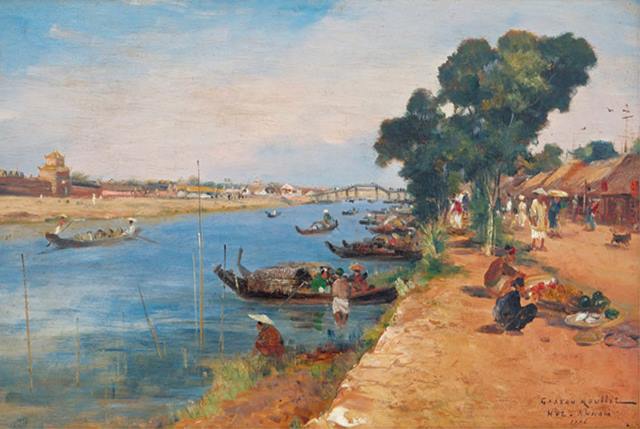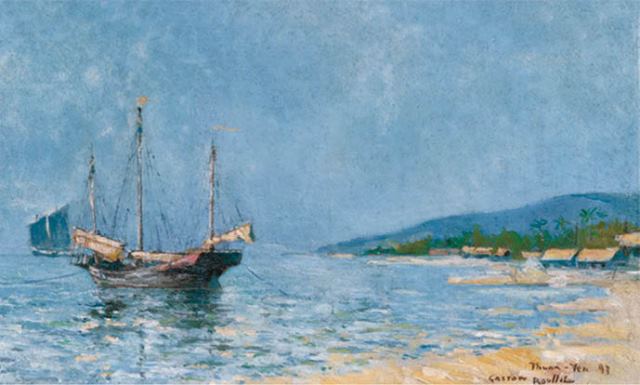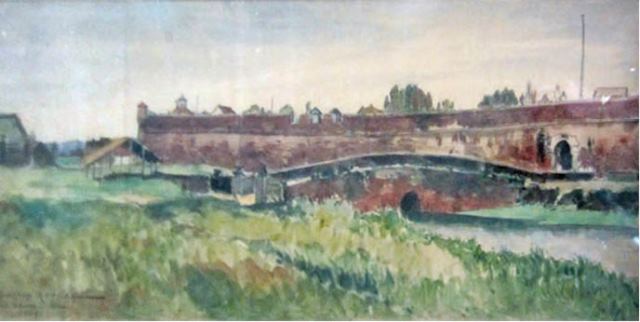
“Dong Ba River in Hue Citadel”
He began to publish narratives and illustrations in magazines such as Le Monde Illustre, Le Journal des Artistes, L'Illustré Moderne... Although he accompanied the expeditionary army under the command of General De Courcy, Gaston Roullet was still able to practice his art as he pleased.
In just a few months of living in Indochina, he had had remarkable results: more than 200 paintings from materials including oil paints, watercolors, and sketches (some of which he later switched to oil paint)…
It is worth noting that, at the same time that Gaston Roullet painted and reported on his journey in North and Central Vietnam, the photographer Charles-Édouard Hocquard also came along as a volunteer ambulance doctor. Roullet and Hocquard met in Hai Phong and became close friends. They came to Da Nang and Hue in early 1886. Going North, he painted many pictures of Ha Long and Hanoi. After that, he went to Da Nang and then to Hue.

The piece "Thuan An Beach"
From Da Nang, Roullet went to Hue by road. He wrote as about the journey through Hai Van pass: “we saw at the foot of the pass very long and narrow boats. Then crossing a big river, we arrived at Lang Co Bay". This peninsula next to the mountains with white sandy beaches and fishing villages was the inspiration for Roullet's very beautiful and poetic oil painting "Lagunes de Long-co".
Arriving in Hue, he visited the mausoleums of the Nguyen emperors. After that, he waited for an audience with the young Emperor Dong Khanh, who had just ascended the throne in September 1885, and painted his portrait.
He recounted the event of painting a portrait of Emperor Dong Khanh: “I approached the Emperor, he extended his hand and I greeted him in a French manner. He was very young and indeed a pretty boy for an Annamite. He looked smart, but in his beautiful royal robe he looked rather effeminate.
“Father Hoang prostrated himself at the emperor’s feet and, in an earnest voice, begged him to sit for a moment and let me draw him. So, in about 15-20 minutes, I was able to sketch in color the shades of the robe and the golden turban on a dark background. It was difficult to express this exquisite silk on canvas even with the purest cadmium yellows. I realized that this painting must be quick, because these minutes were enough for him to get tired of sitting still on the throne.”
“I thought I would use the time to study his appearance, but less than half an hour later, the emperor told me through the interpreter that he could not prolong the audience any longer. The portrait session was over. I approached the standing emperor again and shook his hand twice. I thanked him for the honor and offered him the portrait. Then, he withdrew majestically, with very small steps - slipping, so to speak - between two rows of officials with both hands raising their cards up to their noses.
“Before and while painting the emperor's portrait, I noticed that in the room behind the throne and the mandarins, there were a number of the emperor's women huddled behind the screens. They very boldly glanced at me… this proved that women do not lose their rights in any country.”

The painting “Le Manca à Hué” (The Mang Ca Fort)
During the days in Hue, while Hocquard took pictures, Roullet sketched with a pen, so the Annamese people gave each of them a nickname, the painter was "Mr. Pen Mandarin" and the photographer was "Mr. Light Mandarin"! In a short time, from late 1885 to early 1886, before returning to France to exhibit his art, Roullet traveled and painted many places in Hue.
He painted at least two paintings "Dong Ba River in Hue Citadel" and captioned: "Dong Ba River runs on the outer side, parallel to the entire fortification of the Citadel and connects to the Citadel by large wooden bridges". This is the first oil painting of Hue scenery in early 1886. Gaston Roullet painted from the view from one side of the river, looking diagonally across the river at the Dong Ba Gate and Dong Ba wooden bridge - the first bridge of the Hue Citadel.
There is also another painting by Gaston Roullet of the Dong Ba River, different from the painting "Dong Ba River in Hue Citadel". Dong Ba wooden bridge and Dong Ba gate are set further back and, from there, the boats and scenes of the past inhabitants of Hue Citadel on the river could be seen.
He painted a painting “Le Manca à Hué” recording the fact that the French had occupied Mang Ca Fort under the Treaty of Patenotre signed with the Hue Court in 1884. On the night of July 5, 1885, Ton That Thuyet sent troops to attack the Mang Ca Fort and the Nunciature nearby, but failed. The French counterattacked against the Citadel, the two main mandarins took Emperor Ham Nghi to Quang Tri. This historical painting “Le Manca à Hué” was auctioned in 2015.
He went to Thuan An beach and painted "Thuan An Beach", an oil painting on canvas. The painting shows a peaceful blue color, calm water waves, and a golden sandy beach lying in the sun. Some thatched roofs on the sandy shore are as golden as the sand. In the distance, the mountains are pale green. And offshore, just by the water line, a fishing boat rests with its sails rolled down. In the distance, there is a sailboat that seems to be returning to shore.
Returning to France, in 1886 at the Galerie George Petit, he exhibited about 200 oil paintings, watercolors, and sketches of the North, Central, and South of Vietnam. After that, he attended the World Exhibition in 1889 with 24 paintings of the North and Central areas in the Salon des Peintres Orientalists (1887, 1888, 1896, 1897, 1898, 1899). His paintings had made the world realize the hidden and rich beauty of Hue's nature.
Gaston Roullet died in December 1925 at the age of 78. He was held in high regard by the Association of French Painters and the French Association of Watercolor Painters at that time.
Story and photos: HO THANH NGOC